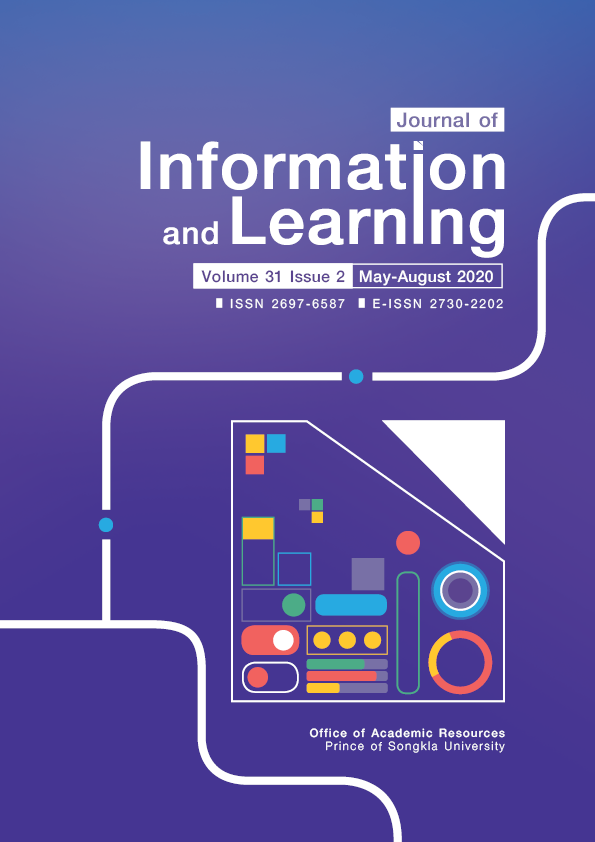The Improvement of Secondary Student’s Creative Thinking by STEM Projects Case Study: Suwanpaiboon School
Main Article Content
Abstract
The aims of this research were 1) to compare students' creative thinking before and after using STEM projects, and 2) to investigate students' beliefs in using STEM projects for developing their creative thinking. Subjects were 30 Suwanpaiboon School students who were selected through purposive sampling. The target group was three students selected from the sample. The tools for collecting data were article creative thinking test and article questionnaire. The research has a quasi-experimental design. Quantitative (using t-test analysis) and qualitative data analyses (describing) were used in this study.
The results illustrated that 1) the students had a higher level of creative thinking at a confidence level of .01 after being involved in the STEM projects, and 2) all the target students believed that their creative thinking could be improved by STEM projects.
Article Details

This work is licensed under a Creative Commons Attribution-NonCommercial-NoDerivatives 4.0 International License.
The Journal of Information and Learning is operated by the Office of Academic Resources, Prince of Songkla University. All articles published in the journal are protected by Thailand copyright law. This copyright covers the exclusive rights to share, reproduce and distribute the article, including in electronic forms, reprints, translations, photographic reproductions, or similar. Authors own copyrights in the works they have created as well as the Office of Academic Resources. The Journal reserves the right to edit the language of papers accepted for publication for clarity and correctness, as well as to make formal changes to ensure compliance with the journal's guidelines. All authors must take public responsibility for the content of their paper.
References
Aizikovitsh-Udi, E., & Amit, M. (2011). Developing the skills of critical and creative thinking by probability teaching. Procedia-Social and Behavioral Sciences, 15, 1087–1091.
The Alberta Teachers’ Association. (2014). 3 Examples-Torrance tests of creative thinking (TTCT). Retrieved from https://innovators-guide.ch/wp-content/uploads/2012/12/torrance-creativity-test.pdf
Byrum, D. (2015). Encouraging Creativity in a STEM Classroom. K-12 STEM Education, 1(1), 13–21.
Gonzalez, H. B., & J.Kuenzi, J. (2012). Science, technology, engineering, and mathematics (STEM): A Primer. Congressional Research Service (1–15). Retrieved from https://www.ccc.edu/departments/Documents/STEM_labor.pdf
Hasani, A., Hendrayana, A., & Senjaya, A. (2017). Using project-based learning in writing an educational article: An experience report. Universal Journal of Educational Research, 5(6), 960–964.
Honeck, E. (2016). Inspiring creativity in teachers to impact students. Torrance Journal for Applied Creativity, 1, 33–38. doi.org/10.1016/B978-0-12-375038-9.00223-5
Jai-on, J. (2017). A thai study of mathematical creativity of students in the lesson study and an open approach context. HRD Journal, 8(1), 74–82.
Kaewkanha, O., Srichumnong, J., & Pawanlanchakorn, J. (2017). Action research on creative thinking development of computer subject in Prathomsuksa 5 student at Bannumque school under the Office of Loei Primary Educational Service Area Office 1, Journal of Education Naresuan University, 19(2), 289–304.
Katanski, D. (2013). Bridging the creativity and STEM crisis. 2013 ASQ Advancing the STEM Agenda Conference, Section 4-2. Retrieved from http://rube.asq.org/edu/2013/04/career-development/bridging-the-creativity-and-stem-crisis.pdf
Ku, S. T. (2018). STEM education. Retrieved from https://www.usinnovation.org/reports/stem-education-us-where-we-are-and-what-we-can-do.
Lou, S. J., Chou, Y. C., Shih, R. C., & Chung, C. C. (2017). A study of creativity in CaC2 steamship-derived STEM project-based learning. Eurasia Journal of Mathematics, Science and Technology Education, 13(6), 2387-2404. doi.org/10.12973/eurasia.2017.01231a
Mayasari, T., Kadarohman, A., Rusdiana, D., & Kaniawati, I. (2016). Exploration of student’s creativity by integrating STEM knowledge into creative products. AIP Conference Proceedings 1708, 080005.
Mihardi, S., Harahap, M. B., & Abdullah Sani, R. (2013). The effect of project based learning model with KWL worksheet on student creative thinking process in physics problems. Journal of Education and Practice, 4(25), 188–200.
Reeve, E. M. (2013). Implementing science, technology, mathematics, and engineering (STEM) education in Thailand and in ASEAN. A report prepared for: The Institute for the Promotion of Teaching Science and Technology (IPST).
Sarah, P., & Dean, M. (2018). Inspiring creativity through STEM curriculum. Retrieved from https://fellows.applied.org.au/Documents/Events/presentations/2017-education-forum/maddison-stem-education-24-02-2017.pdf
White, D. (2014). What is it and why is it important?. Florida Association of Teacher Educators Journal, 1(14), 308–313. doi:org/10.1136/bmj.322.7301.1536.


